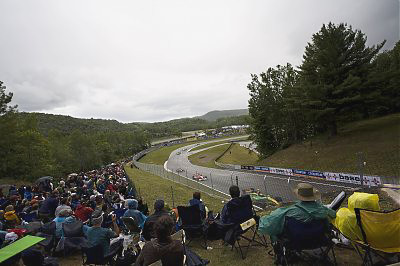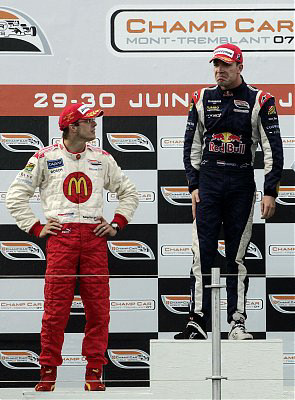The Way It Is/ Enjoying the rebirth of one of North America's greatest road courses
by Gordon Kirby What a pleasure it was to drive up to Mt. Tremblant in Quebec's Laurentian Mountains last weekend for the first major professional race at the track in almost thirty years. Back in the seventies I covered many races at Mt. Tremblant so I've been eagerly looking forward to Champ Car's first race at the great old road circuit. I wrote a memoir about Tremblant in this space on January 3rd of this year and was filled with many nostalgic memories as I drove north through Montreal and into the natural beauty of the Laurentian Mountains.
What a pleasure it was to drive up to Mt. Tremblant in Quebec's Laurentian Mountains last weekend for the first major professional race at the track in almost thirty years. Back in the seventies I covered many races at Mt. Tremblant so I've been eagerly looking forward to Champ Car's first race at the great old road circuit. I wrote a memoir about Tremblant in this space on January 3rd of this year and was filled with many nostalgic memories as I drove north through Montreal and into the natural beauty of the Laurentian Mountains.
During the eighties and nineties the track fell into disrepair but it was purchased in 1999 by Lawrence Stroll who completely repaved the undulating 2.65-mile track for the 2001 racing season. Today the circuit is probably the smoothest race track in North America, if not the world. New walls, fencing, guardrails and run-off areas were also installed and further work was done on these details as well paving a portion of the paddock in order to stage last weekend's Champ Car race. Over the past eight years Stroll has spent between $6 million--$7 million on refurbishing the place.
And well worth it too, because Tremblant is a superb track with many fast corners and plenty of changes in elevation. It's a treat for drivers and fans alike and is very intimidating in places with little or no room for error. Inevitably, the long rising and plunging first turn--one of the most spectacular corners in all of racing--had to be fitted with a chicane because the speeds of today's cars through there in unrestrained fashion would have been much too fast, particularly with the utter lack of any run-off room.
"The whole track is very challenging," commented Champ Car's triple champion Sebastien Bourdais. "It's just plain fast everywhere. Other than the chicane, there's not much room for error. If you overdrive and make a mistake, you're going to hit and you're going to hit hard. It's one of those tracks where you know you've got to push. It's super important because that's where the lap time is coming from.
"In the meantime, you always have to keep in the back of your mind you've got to stay in between the white lines. That's the biggest challenge. You have to drive with some sense of compromise, speed and making it, because if you wreck, it's probably going to be the end of the weekend."

© LAT USA
Champ Car's Tremblant pole winner Tristan Gommendy compared the track to Belgium's legendary Spa-Francorchamps course. "This track is very nice, very smooth," Gommendy. "If I want to compare to a European track it's maybe like Spa, but smaller. It's a little bit like Spa, a very nice track."
Mark Hughes recently wrote somewhat facetiously in Autosport that maybe the right way forward for the sport is to turn its back on the inexorably commercial path of racing more and more in cities or close to urban centers and return to its sporting roots of racing on real road courses in beautiful rural settings. Mt. Tremblant last weekend demonstrated that there might be more good sense to this idea than many people think. A healthy if not huge turnout of real race fans--announced attendance figures were 42,000 over the three days, including 25,000 on raceday--were into touring the track and watching from many vantage points as the place showed everyone who was there that there's nothing like a classic road course from the sixties.
The CanAm started its epic eight-year run at Mt. Tremblant back in 1966 and the inaugural CanAm series went on to race at Bridgehampton, Mosport, Edmonton, Laguna Seca and Riverside--all of them great old-style road circuits. Bridgehampton, Riverside and Edmonton have since been lost to urban sprawl and development but Laguna, Mosport and Tremblant remain. The CanAm rose to legendary prominence by competing on these classic road courses located off in the countryside where the cars could stretch their legs and demonstrate their cornering power as well as straightaway speed.
It was the spectacle of pure performance rather than wheel-to-wheel racing which made the CanAm so successful, if only briefly. Is it possible that the same theory can be applied to racing today, to provide an environment in which the cars and the sport can be better appreciated rather than confining the cars, week after week, to tight speed-restricting street circuits?
Sunday's Champ Car race was a serious test for the drivers because it rained off and on throughout the afternoon, keeping everyone on their toes. It seemed that everyone made at least one mistake in the tricky conditions and some drivers made multiple errors. In the end, Dutch rookie Robert Doornbos scored both his own and Paul Stoddart's Minardi team's first Champ Car victory, beating defending champion Sebastien Bourdais who slithered off the road on one of the race's wet restarts, dropping as far back as thirteenth. Bourdais came back to finish second, but he was beaten soundly by Doornbos with Will Power third.

© LAT USA
Later, in the post-race interview, Bourdais and Doornbos argued their cases and Bourdais took it upon himself to continue discoursing at great length on the matter. Even though many people complain that Bourdais is an habitual whiner he is an excellent driver with a breadth of experience at Le Mans and in the IROC series that few other open-wheel drivers anywhere in today's world can match. He deserves a proper shot at Formula 1 and I hope he gets it next year with the Toro Rosso team.
Sebastien is very sharp technically and I'm sure he would produce great results if the Toro Rosso team is permitted by the FIA to race the latest Adrian Newey-designed Red Bull chassis. The FIA is debating whether or not customer cars will be permitted in F1 which would enable Scuderia Toro Rosso to race its parent team's Red Bull chassis.
"If the customer car proposal is accepted and the team is able to get the same stuff as Red Bull direct from Red Bull technology it should be pretty good," Bourdais said. "But that's only if because right now there's still a battle over the customer car idea."
Bourdais will test again for Toro Rosso at Spa on July 12 and the Frenchman believes the results of the test will be critical to his hopes of breaking into F1. "As complex as it is, it's very simple," Bourdais commented. "It comes down to the next test I'm doing and how it goes and the performance I do. They'll decide by the end of the month what they want to do with the whole situation."
Scuderia Toro Rosso are known for putting maximum pressure to perform on their current drivers Vitantonio Liuzzi and Scott Speed but this kind of tactic does not appeal to Bourdais who believes in self-motivation.
"Obviously, we'll have to talk a little bit about their vision of managing drivers," Bourdais remarked. "They've complained a lot about their drivers but I think if they weren't putting a knife at their throat everytime they jump into the cars it might actually serve them a little better. But that's only my opinion.
"So we'll see. It's one of these things I think where before you get into a relationship, if it's proposed, you've got to talk and expose your view of the whole thing and have them explain their views and see if it's compatible. That's very much where I'm at right now."
For Bourdais to make the move to F1 and do it well would also be a good thing for American open-wheel racing which has zero credibility in the modern F1 world. Much of this is a result of the the deeply debilitating twelve year old CART/IRL split, but it dates back to Michael Andretti's failed 1993 F1 season and includes Alex Zanardi's unhappy return to F1 in 1999 after winning back-to-back CART titles the previous two years. Right or wrong, succeeding in IRL or Champ Car today means nothing to F1's team bosses. Just ask Dario Franchitti, Dan Wheldon, Justin Wilson, Helio Castroneves or Tony Kanaan.
By returning to places like Mt.Tremblant Champ Car may slowly be able to rebuild its image and reputation both with North American fans and the European racing community. Plans call for at least four more years of Champ Car racing at the track so let's hope Champ Car's first visit to Tremblant is the start of a positive new trend for the much-criticized series.
Auto Racing ~ Gordon Kirby
Copyright 2007 ~ All Rights Reserved
Copyright 2007 ~ All Rights Reserved
Top of Page